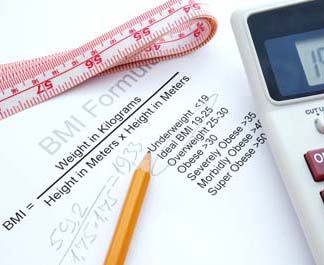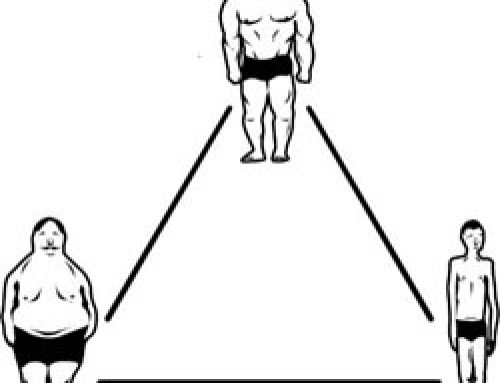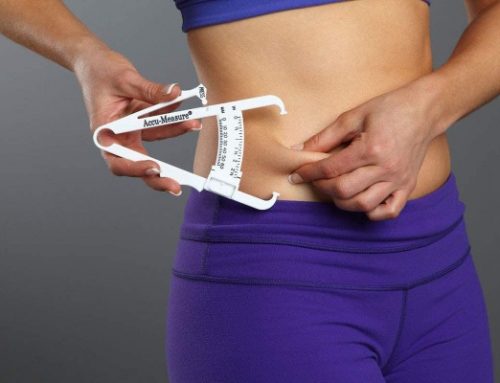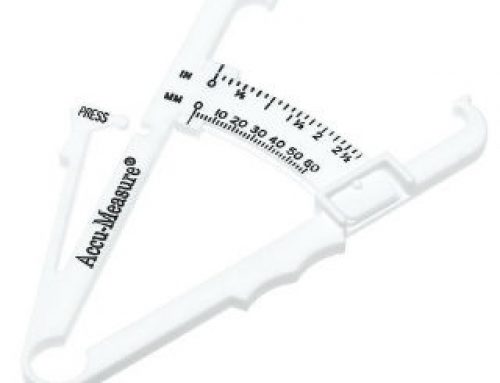Most people who are dieting and exercising judge their success on one number: body weight. If they lose body weight, they feel like they’re on track. If they gain body weight, they feel off track. However, making body weight the only number you measure or even your primary measure of progress is a big mistake.
The weight loss industry is using the wrong measuring stick.
 Bodybuilders, who need to be both lean and muscular, are one group of people who have always known about the right measuring stick. But the mainstream diet world is completely out of touch with this critical concept:
Bodybuilders, who need to be both lean and muscular, are one group of people who have always known about the right measuring stick. But the mainstream diet world is completely out of touch with this critical concept:
The most important success measurement is not body weight, it’s body composition: how much of your weight is muscle and how much is fat.
A perfect example of how the weight loss industry and even respected educational institutions are still failing us is the continued popularity of the body mass index or BMI.
The BMI is a math equation. It is calculated by dividing your weight in kilograms by the square of your height in meters. The resulting number is supposed to tell you if you’re overweight or obese, healthy or unhealthy, based purely on your height and weight.
Here is the BMI rating scale:
Underweight = <18.5
Normal weight = 18.5–24.9
Overweight = 25–29.9
Obesity = BMI of 30 or greater
The Center for Disease Control (CDC) and The Mayo Clinic have BMI calculators on their websites. The National Institutes of Health in Washington DC has a BMI app. This tells me that large, prestigious and influential heath organizations must think BMI is important.
I’m here to tell you that BMI is BS! The BMI tells you nothing about body composition or fitness.
Advocates of BMI say that it correlates with body composition and is a better gauge of health than your weight alone. The truth is, BMI might be an acceptable screening tool for the sedentary broad population. But for many people, BMI is just as misleading as those old insurance company height and weight charts.
For athletes or fitness enthusiasts, BMI is practically worthless for both men and women.
A bodybuilder or strength athlete could easily have a “dangerously high” BMI of 30, but a healthy, low level of body fat. According to the BMI, almost every player in the National Football League is overweight, and some contestants in the Mr. Olympia competition are “morbidly obese” with BMI’s of 40, even though there’s not an ounce of visible fat on their bodies.
If I plug my height (5’ 8”) and weight (195 pounds) into the BMI calculator, it says my BMI is 29.3. That classifies me as “borderline obese.” Anyone who has seen me knows, of course, that this is ridiculous.
As a bodybuilder, I simply have a higher than normal level of lean body mass, so I weigh more than the average guy my height. My body fat level is very low – usually around 10%, give or take a percent or two. That puts me in the “excellent” or “athlete” category for body composition.
Your BMI or your body weight alone can never tell you everything you need to know about your current health or body composition, or the progress you’re making toward your fat loss or muscle-building goals.
Suppose a girl jumps on one of those trendy “lose 30 pounds in 30 days” crash weight loss diets and she actually does drop from 160 to 130 pounds quickly. She weighs less and she’s wearing a smaller size. But was she really successful? We don’t know, because she was only focusing on the scale, which told her how much weight she lost, but not what kind of weight she lost.
If she measured her body composition, she might see that because of the unhealthy fad diet she used, and because she wasn’t doing the right training, she lost only 15 pounds of fat and the other 15 pounds came from lean body mass. When half of your weight loss comes from muscle, that’s not a success.
This also explains how she may fit in smaller clothes, but out of clothes she still looks flabby and un-athletic, like a smaller version of her previous body. She has become what we call, a “skinny fat” person.
If you’re not aware of body composition, the scale can fool you when it moves in the other direction as well. There are two sides to improving body composition: Less fat and more muscle.
Women don’t add muscular body weight or muscle size easily, but men often do. It’s entirely possible, especially for the guys and for beginners to weight training, to gain muscle while losing fat, and the increase in muscle offsets the loss of weight on the scale. If you build muscle, some people may see little or no drop on the scale at all. If you were scale-focused alone, you’d think you failed, but your body composition actually improved.
Body composition is the name of the game and that’s where you should put your focus.
I’m not saying you should ignore your body weight. Some trainers think you should toss your scale in the garbage can, but research says people who weigh themselves have a higher success rate.
What I’m saying is that body weight alone doesn’t tell you the whole story. If you take both measurements, body weight and body fat percentage, you can easily calculate those two critically important numbers: pounds of muscle and pounds of fat.
Here’s an example, using round numbers that make the math simple to do in your head:
Body weight: 200 pounds
Body fat: 10%
Fat mass: 20 pounds (10% of 200 pounds)
Lean mass: 180 pounds (200 pounds total weight minus 20 pounds of fat weight)
Now you’re using the right yardstick – the true measure of success – body composition. And now you know that the goal you’re after is not just a number on the scale. If you’re moving in the direction of more muscle, less fat, or both, that’s how you know you’re making real progress.
In next Monday’s post, we’ll continue in this thread and answer the question, “Is it really mandatory to measure your body fat?” I think I’ve made a pretty great case for testing and tracking body fat levels, but believe it or not, some trainers are now saying we “shouldn’t bother.”
Until then, Train Hard and Expect Success!
– Tom Venuto
PS. The Burn the Fat, Feed the Muscle system of fat burning is different than most “weight loss” programs. Burn the Fat Feed the Muscle is based on the methods of natural bodybuilders and fitness models, who have always focused on the muscle to fat ratio first and not just scale weight. To learn more about how to transform your body composition from fat to muscle, literally at will, using the right combination of nutrition and training, read the Burn the Fat, Feed the Muscle book – buy now on amazon, get more details at: www.BurnTheFatFeedTheMuscle.com OR check out the new Burn the Fat 7-day online course and support community at www.BurnTheFat.com
Tom Venuto is a natural bodybuilder, fat loss coach, fitness writer and author of Burn The Fat, Feed The Muscle. Tom’s articles are published on hundreds of websites worldwide and he has been featured in Muscle and Fitness, Men’s Fitness, Oprah magazine, The New York Daily News, The New York Times and the Wall Street Journal. He has appeared on dozens of podcasts and radio shows including Sirius XM, ESPN-1250, WCBS and Day Break USA. Tom is also the creator of the new Burn the Fat 7-Day Body Transformation System and the founder and CEO of the premier fat loss support community, the Burn The Fat Inner Circle.
Related Articles:
Your Scale is a a Liar, But Don’t Throw It Out
How to Lose 20 Pounds, Really, Really, Really Fast
The Ultimate Guide To Skinfold Calipers And Body Fat Testing
How To Calculate Your REAL Ideal Bodyweight (Members-Only Area)
Ideal Body Weight Calculator (Members-Only Area)
Online Body Fat Calculator (Member’s Only-Area)







Thanks Tom! I believe this right on. Over time I’ve found that training my body to reduce body fat composition and at least retain acceptable muscle mass based on my desire, requires a process that starts with accepting the reality of what it really takes to change body composition in a meaningful and evident way. The truth is, it can be hard. Especially getting started and at leveling off points. My body will give up body fat will with the actions and formula that work for me. (MUCH OF WHICH IS BASED ON BBFM :) However to get er done, I have to coax my body into the fat burning mode. When I shift into fat burning, muscle building mode, my biology and psychological self perceive a lack situatuin. To some degree fight or flight and self preservation instincts kick in. I think each person has to find the technique and as importantly the EFFECTIVE RATE for conditioning the body to give up fat without while dealing with feelings of fear and deprivation if and they kick in. That’s why I am strong proponent of appropriate pacing for fat loss based on the individual situations, wherein slow progression is not a nasty or dreaded term. A half pound loss of body fat a week over time that increases to what ever level that gets consistent progressive results,is nothing less than a fabulous success. We need to educate ourselves (YOUR INFORMATIVE ARTICLES AND CONTENT ARE A GREAT SOURCE.) And I think we just need to pay more attention to balanced guidance, get in touch with our bodies, and block out all the BS. Thanks again Tom!
Thanks Scott. right on about appropriate pacing. most people have tried the “rapid / crash” weight loss thing and we’ve even looked at the “science” of it here on Burn the Fat Blog, but in the long run, almost everyone comes to agreement in concluding that slow and steady progression and constant improvement is the name of the game.
My husband has a hydrostatic body fat mobile unit and tests athletes all the time at their gyms/boxes. It is very liberating for people to know the truth about their bodies and where they stand with their body fat. This is 98.7% accurate. I couldn’t wait to get tested! My BMI always says that I am obese. I am not. I am athletic and very muscular at 18%! It is so great to know the truth. It’s true! BMI is BS!
Hi Tom … As a longtime follower and purchaser of your BFFM back in 2004, there is nothing you have posted that I haven’t agreed with you on! You are absolutely correct in your latest blog post: BMI is B.S.! I have tried to win this argument with others and now I have your post to back me up. As always, you are amazing and a real inspiration!
This article re:BMI is so true. I came down from 280 to 128 and the frustrating thing is my legs looked pretty good but my torso looked like a smaller version of my bigger self. I still had a huge amount of fat on me even though my BMI was 17. BMI is BS. It really is time to back off from the scale and work on body composition. I lost totally the wrong way and lost alot of lean muscle which I had worked hard to build, not to mention my body and brain want more food and I craved carbs and gains more than 100 lbs back in only a few years because I did it all the wrong way. Also the people around me also influenced me on the wrong path. Your articles are based on the truth. Now I am ready to go on that journey all over again, only this time the scale will not be my measuring stick.
I totally agree. I have known this for years and been treated like a fool for saying it. Healthy bodybuilders are turned down for life insurance because they have a high BMI. I am one of those women who can put on muscle. but even were I not, it only takes a bit of common sense to see this is just used because it is easy, not because it is accurate.
“The BMI is a math equation.”
That’s it, Tom. That’s where the problem begins.
The Center for Disease Control and The Mayo and The National Institutes of Health in Washington DC all have quite a bit of clout in this country and, as a result they influence millions of people. This is the most sane and accurate response to the BMI equation I have seen. Thanks for setting the record straight.
The BMI serves no purpose on an individual level unless used to investigate further. However, I do think the BMI serves a purpose when you have 500 people to get thru in a day and need to quickly categorize individuals into groups to be looked at individually. Using the BMI as the first and last step is the wrong tool to use as you point out. I’m overweight and have been for years via the BMI. However, it serves no purpose on an individual level. But put 100 people in front of me and give me a time limit, it’s a quick method to group people for further investigation. Sadly most technicians who use this method don’t go the next logical step and that is confusing and serves no useful purpose to the person getting some useless BMI score without any frame of reference.
It seems the scale is really skewed at the tall end of the spectrum (not to mention against athletes in general). At 6’7″, the only way I can get down to a “normal weight” is to reach ~208. I’m pretty sure I’d be well below 10% body fat, but would also lack a bit of muscle mass as well!
My big fear: I’m worried that BMI will soon by tied to health insurance premiums. Let’s all hope not!
Let say you are 5’8 195lb at 12% bf and you were somehow able to get yourself to 220lbs and actually lower your bf to 8%. Are you healthier at 195lbs or 220lbs? Just being devil’s advocate here. Maybe it’s not healthy to be 5’8 and 220 at any BF level.
Eddie, if this example were taken to a more extreme level, I would say you were right – that its very possible not to be healthy at a lean, but heavy body weight. But i personally dont think that would happen at only 220 natural (which by the way, would require a “freak” outlier in the mesomorph/ muscularity genes department).
If it were a superheavy weight like 260, 280, 300 and lean (which we’re going to assume is the product of some “not natural assistance”) i think we could easily argue that it might not be healthy; purely to have a body that size – regardless of whether that huge amount of weight per inch of height is muscle or fat. Add on the effect of drugs and it may multiply the risk. Add on a large layer of fat on top (like 300 lb+ strongman who doesnt care about body comp) and multiply the risk again.
In fact, I bet we could make a list of strength athletes, pro wrestlers, strongmen etc who fit that description and had heart attacks at a young age.
Then on the OTHER hand there is such a thing as the metabolically healthy obese. more info on that here:
https://www.burnthefatblog.com/archives/2011/04/obesity-paradoxes-fat-but-still-fit.php
bottom line though is while you raise a really good point, I dont think the steroid-free, drug-free lean athlete is going to reach a body weight (heavy enough) to add any health risk. I suspect the opposite: natural muscle, even more than the average person walks around with, is extremely healthy on multiple levels. (looks good too!)
Cheers!
PS 195 is more like an “off-contest season” weight for me. while that may be in the athlete or lean ctegory based on body fat %, Im not REALLY ripped up until Im more like 180-185 and actually used to hit middleweight (176 lbs) on the day of a contest). These kinds of weights are more typical of natural guys.
Thanks Tom.
off the subject here,` but noticed your PS. I’m 43 5’9 and also start to get ripped at 180lbs and get pretty lean at 172lbs. I always wanted to try to get to 190lbs and a six pack. Is this almost impossible naturally?
While all of this makes perfectly good scientific sense….The realization from the medical community is that not everyone is a bodybuilder. Most Bodybuilders fall into the overweight or obese BMI range.
BMI correlations were surmised by statistics….so in the untrained or non athletic or marginally athletic majority BMI is STATISICALLY a predictor of health.
Now if anyone has done any statistics work…..Body Builders fall into the category of OUTLIERS. Meaning they fall out of the statistical norm.
My Physician is an exception…he has done the research and written a textbook on Metabolic Medicine…he has tremendous clinical research experiences to draw correlation on abdominal fat and insulin resistance and how it impacts Leptin and Adiponectin…when then correlate to general cardiovascular health and other diseases.
So my physician would side with you…..If I could lift up my shirt and show him a six pack and single digit body fat measured using BEI he wouldn’t care if it took a crane to get me in his office.
So indeed….If You got a doctor that calls a specimen like yourself obese….then you simply…have the wrong doctor.
However the bad side of this is that things like your health insurance premium are tied into such ignorance…and that is what needs to change.